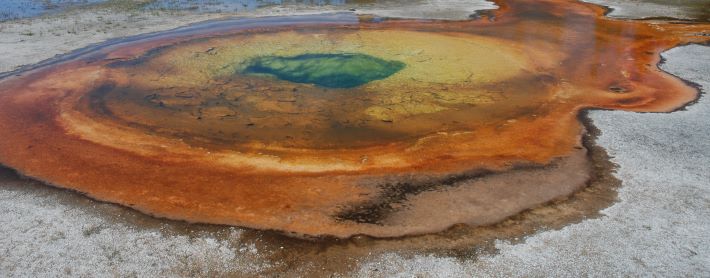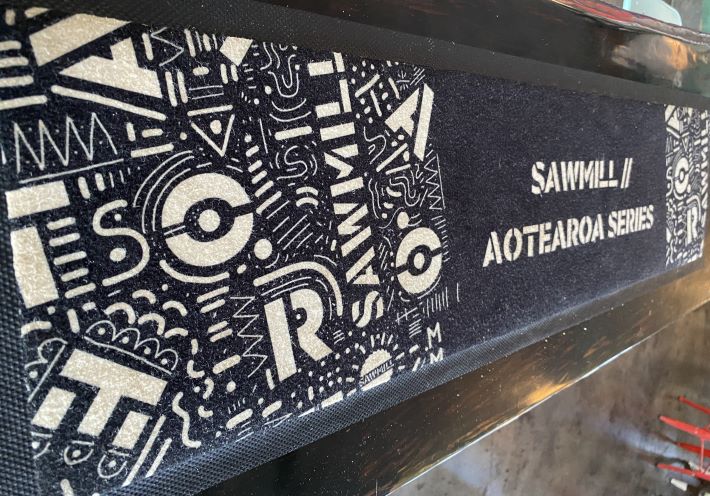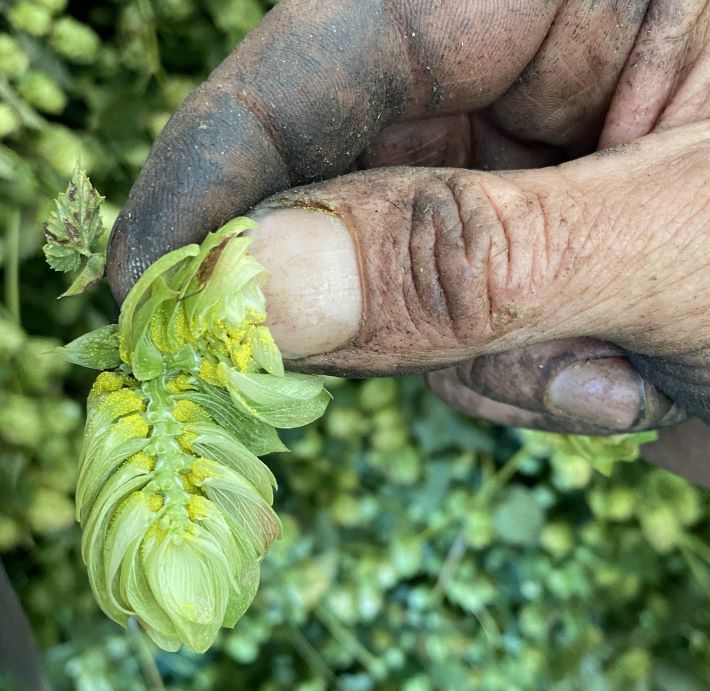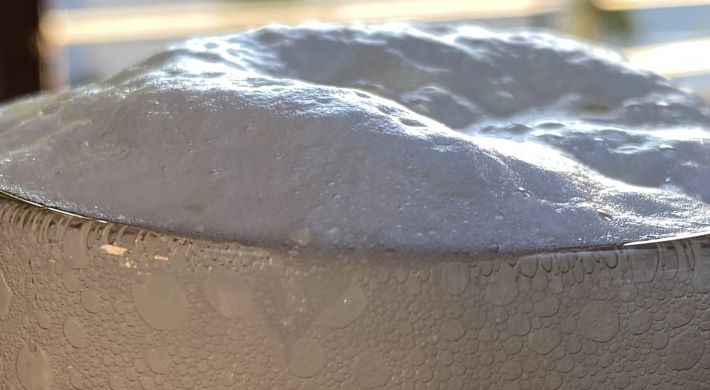 Sun setting over field of barley at Wheatland Spring Farm + Brewery
Sun setting over field of barley at Wheatland Spring Farm + Brewery
[Begin disclosure] I once owned the domain name beerterroir.com. Like a dozen other urls I paid rent on it a few years before I let it disappear into a distant corner of the internet. It’s available, should you want to claim it.
I registered it in 2006, only hours after Sam Calagione made fun of the word terroir in his Craft Brewers Conference keynote. (More on that in a moment.) But I wasn’t inclined to use the word as it relates to beer in a sentence. I understood it was (and is) considered a “wine word” and even so writer Jamie Goode described the concept in wine as “blindingly obvious and hotly controversial.”
I became more comfortable with the word as I researched “For the Love of Hops” and continued with “Brewing Local,” although I continue to prefer “taste of place.”
Amy Trubek concludes “The Taste of Place: A Cultural Journey Into Terroir,” an absolutely terrific book, by writing “ . . . the taste of place exists, as long as it matters.” To repeat myself, I’m more inclined to use the words taste of place opposed to terroir, but I’m fine with “beer terroir exists, as long as it matters.” Both matter to me.
Friday I moderated a panel discussion about these and other related topics held in a barn on Wheatland Spring Farm + Brewery in Virginia along with a winemaker/grape grower, a cidermaker, a James Beard award winning chef, and a brewer/farmer. I am invested, and that bias informs how I think about terroir. [end disclosure]
Which brings us to Monday morning. Right after I posted TWTBWTW I opened my feed reader and saw the headline, “There is No Such Thing as Terroir in Beer.” I looked at the list of things I intended to have done by the end of the day and thought, “No time for this.” Remember, though, I’m invested. I wanted people to read the story, because I am happy when they give terroir or taste of place some thought, even when I don’t agree.
That’s why I posted a link on Twitter. I already knew I was going to write something like this when I had time, but I included the briefest summary possible of what I thought of the headline: “Wrong.” I guess Matt Curtis, who wrote the story, was offended. He called this a “tad unprofessional.” Perhaps I should have typed, “Disagree.” Anyway, he also asked “Why?”
So here goes. Bullet points, because otherwise . . . The first chapter of “Brewing Local” is about “beer from a place” and runs about 8,000 words. And a recent Hop Queries contained more than 2,500 words on hop terroir itself.
– “Grand dictionnaire universel du XIXe siècle,” Pierre Larousse’s nineteenth century French dictionary, defines terroir as “the earth considered from the point of view of agriculture.” It describes le goût de terroir as “the flavor or odor of certain locales that are given to its products, particularly with wine.”
– Trubek prefers what she calls the “French foodview,” arguing that in France the narrow scientific and broad cultural definitions of terroir are often used simultaneously. “This broader definition of terroir considers place as much as earth. According to this definition, the people involved in making wine, the winemaking tradition of a region, and the local philosophy of flavor are all part of terroir,” she wrote. “Unlike the narrow view of terroir, this humanist point of view is not really quantifiable. Terroir speaks of nature and nature’s influence on flavor and quality, but here the human attributes we bring to ‘nature’ are cultural and sensual rather than objective and scientific.”
– There is real science behind terroir, although that doesn’t have to limit how we think about it. Here’s an example I use all the time, from geneticist John Henning at the United States Department of Agriculture research facility in Oregon. Environment and epigenetics combine to make hops from a particular area unique. All plant species have methylated DNA, which causes some genes to be “switched on” more easily than others.
Differences in soil, day length, temperatures, amount of rainfall, and terrain all may influence the methylation process. The underlying DNA does not change, but the methylation pattern can be different, resulting in differing concentrations of the chemical compounds produced by the plant.
– At Freestyle Hops in New Zealand, they draw a distinction between this science of terroir and what they call “terroir expression.” It mirrors Trubek’s French foodview. The expression is a combination of the environmental factors, cultural practices, the operating processes and the individual people at the farm who create the flavor of their hops. CEO Dave Dunbar says, basically, that New Zealand has a unique terroir (blame a nearby hole in the ozone if you want) for hops, a good thing, and that Freestyle seeks to build on that, to create a better thing.
– As promised, from Calagione’s 2006 keynote: “If you can’t blind them with science, blind them with geography. Je parl francais en peu, and I’m pretty sure the translated definition of terroir is ‘dirt’. The wine world has wrapped this one word with mighty voodoo powers and created a cult of exclusivity around it. Breweries have terroir as well. But instead of revolving around a patch of land, ours are centered on a group of people.”
– In the penultimate paragraph (you know, the one in which Wallace or Stringer Bell dies) of “No Such Thing” Curtis writes, “I accept that you could produce a beer using ingredients grown on a single farm, brewed with the same untreated well water that was also used to irrigate the hops and barley used in its production, and fermented only with the yeast airborne above those same fields. You could even take this a step further and not boil it, creating a ‘raw’ beer, further removing the human element that takes the nature of a beer away from the land on which it was born. I believe there is a future for a small amount of beer to be produced in this way, even if this method is as challenging as it is commercially unviable. Yes, you can connect beer to its agriculture and its seasonality, but this is not the same as its flavour being a direct expression ‘of the earth’.”
– That seems like a limited view to me, based on a narrow definition. In my view, beer does not reflect its terroir by accident. Brewers matter. Different beers at Wheatland Spring taste of the 30 acres the farm sits on in different ways. They are all brewed with the same intention, to connect the land and the beer.
They are made with the same well water. Some are fermented with wild yeast collected on the property. Some are brewed only with estate grains, some include grains from nearby. There will be more. Saturday, Nicholas Santantonio, the breeder at Virginia Tech, grabbed spikes off experimental plants Wheatland Spring is trialing and talked about their most important attributes. They are better suited to grow in the region and they deliver unique, desirable flavors.
– I have, somewhat by chance, tasted batches 1, 2 and 4 of Wheatland Spring Estate Return, brewed with estate barley. They taste of the same, but not exactly the same as each other. Also not quite like any other beer. Trubek once shared an office at the New England Culinary Institute with Mark Davis, a teacher and trained wine sommelier. He told her, “Terroir is character. It is the triumph of diversity over homogeneity.”
Saturday, I saw the genesis of more of that in the test plots at Wheatland Spring.
“No Such Thing” concludes, “Although, I still believe in the potential for beer to truly express a sense of place, but maybe that place isn’t a field, or an orchard, or a hillside. Maybe, that place is one with dark wooden furniture, and a deeply worn, patterned carpet. One soundtracked by the hum of gentle chatter, and a friendly face behind the bar that asks the question ‘same again?’ If beer is expressive of anything, then this expression is found, not where it is grown or made, but where it is served, and this, surely, is what makes it so special.”
This expansive view of terroir or taste of place mirrors one put forth in “Beer Places: The Microgeographies of Craft Beer.” The book is a collection of essays, mostly by academics, and contains phrases like “banal authenticity” and “spatial politics” that are at least as hard as terroir to wrap your head around.
The authors of the introduction write, “The taste of place refers to the unique flavors and experience of each beer, and how these embody the webs of ingredients, social networks, and layers of place that converge on the production and consumption of craft beer.”
“Webs of ingredients” does not seem to acknowledge the role agriculture plays in taste of place as much as I’d like. But that’s not something I intend to take up on Twitter. The fiery conversations that “No Such Thing” ignited are still burning bright and I have no interest in participating.



